YAMAHA PW50 2013 Workshop Manual
Manufacturer: YAMAHA, Model Year: 2013, Model line: PW50, Model: YAMAHA PW50 2013Pages: 76, PDF Size: 1.67 MB
Page 51 of 76
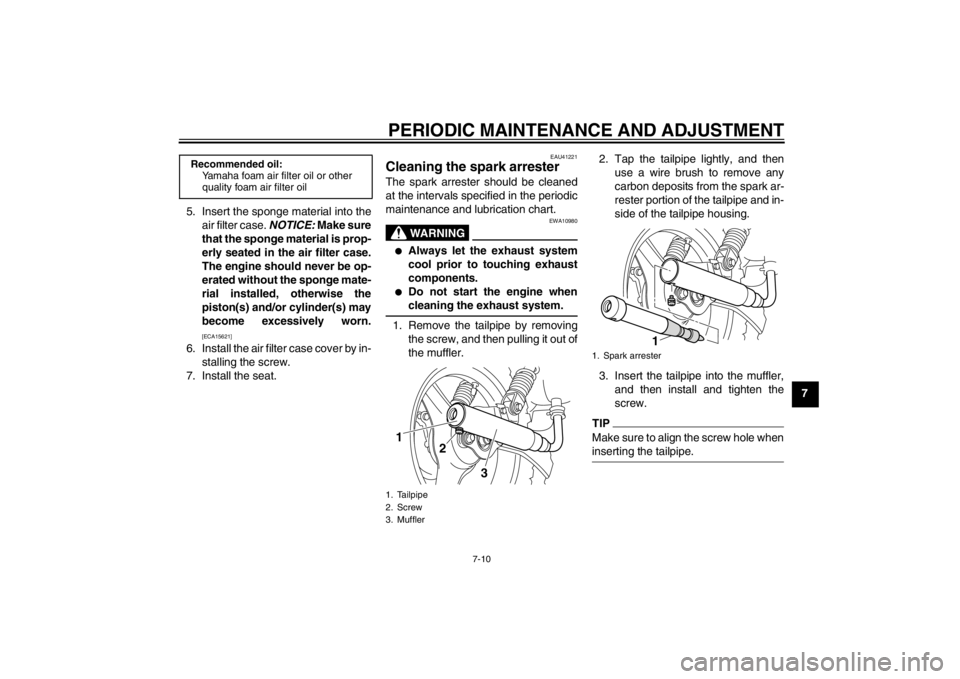
PERIODIC MAINTENANCE AND ADJUSTMENT
7-10
7
5. Insert the sponge material into the
air filter case. NOTICE: Make sure
that the sponge material is prop-
erly seated in the air filter case.
The engine should never be op-
erated without the sponge mate-
rial installed, otherwise the
piston(s) and/or cylinder(s) may
become excessively worn.
[ECA15621]
6. Install the air filter case cover by in- stalling the screw.
7. Install the seat.
EAU41221
Cleaning the spark arrester The spark arrester should be cleaned
at the intervals specified in the periodic
maintenance and lubrication chart.
WARNING
EWA10980
●
Always let the exhaust system
cool prior to touching exhaust
components.
●
Do not start the engine when
cleaning the exhaust system.
1. Remove the tailpipe by removing the screw, and then pulling it out of
the muffler. 2. Tap the tailpipe lightly, and then
use a wire brush to remove any
carbon deposits from the spark ar-
rester portion of the tailpipe and in-
side of the tailpipe housing.
3. Insert the tailpipe into the muffler, and then install and tighten the
screw.
TIPMake sure to align the screw hole when
inserting the tailpipe.
Recommended oil:Yamaha foam air filter oil or other
quality foam air filter oil
1. Tailpipe
2. Screw
3. Muffler1
2
3
1. Spark arrester
1
U5PG8BE0.book Page 10 Wednesday, June 27, 2012 2:53 PM
Page 52 of 76
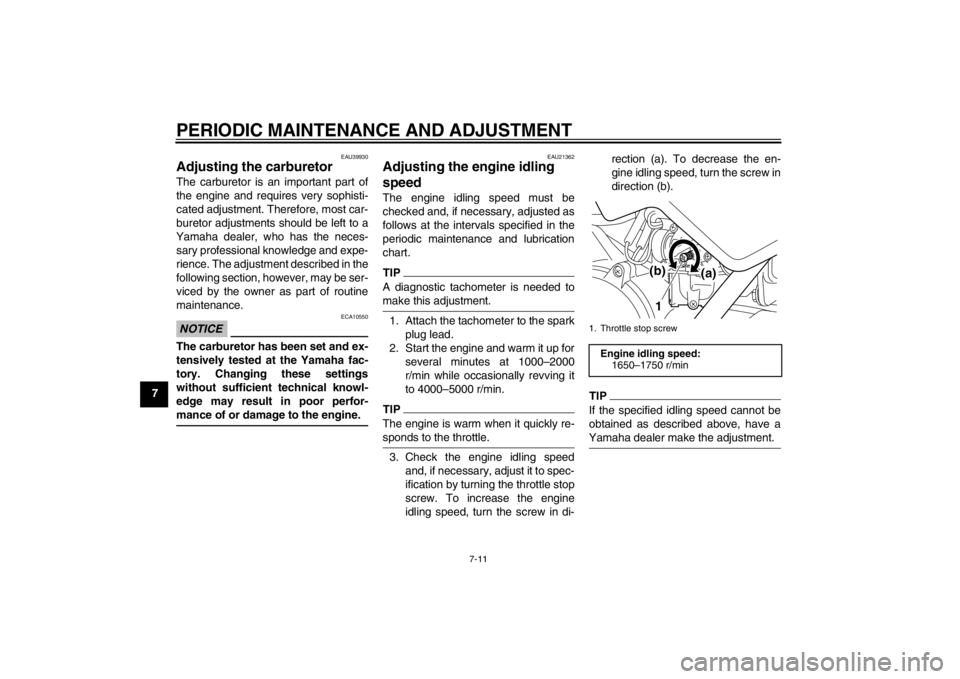
PERIODIC MAINTENANCE AND ADJUSTMENT
7-11
7
EAU39930
Adjusting the carburetor The carburetor is an important part of
the engine and requires very sophisti-
cated adjustment. Therefore, most car-
buretor adjustments should be left to a
Yamaha dealer, who has the neces- sary professional knowledge and expe-
rience. The adjustment described in the
following section, however, may be ser-
viced by the owner as part of routine
maintenance.NOTICE
ECA10550
The carburetor has been set and ex-
tensively tested at the Yamaha fac-
tory. Changing these settings
without sufficient technical knowl-
edge may result in poor perfor-
mance of or damage to the engine.
EAU21362
Adjusting the engine idling
speed The engine idling speed must be
checked and, if necessary, adjusted as
follows at the intervals specified in the
periodic maintenance and lubrication
chart.TIPA diagnostic tachometer is needed to
make this adjustment.1. Attach the tachometer to the spark plug lead.
2. Start the engine and warm it up for several minutes at 1000–2000
r/min while occasionally revving it
to 4000–5000 r/min.TIPThe engine is warm when it quickly re-
sponds to the throttle.3. Check the engine idling speedand, if necessary, adjust it to spec-
ification by turning the throttle stop
screw. To increase the engine
idling speed, turn the screw in di- rection (a). To decrease the en-
gine idling speed, turn the screw in
direction (b).
TIPIf the specified idling speed cannot be
obtained as described above, have a
Yamaha dealer make the adjustment.1. Throttle stop screwEngine idling speed: 1650–1750 r/min
1 (a)
(b)
U5PG8BE0.book Page 11 Wednesday, June 27, 2012 2:53 PM
Page 53 of 76
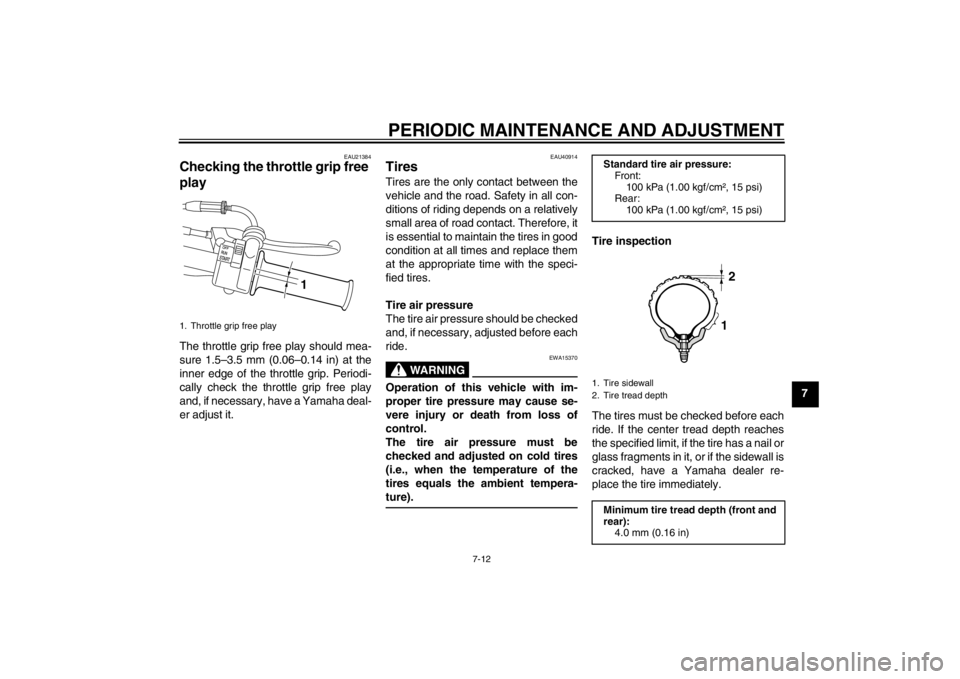
PERIODIC MAINTENANCE AND ADJUSTMENT
7-12
7
EAU21384
Checking the throttle grip free
play The throttle grip free play should mea-
sure 1.5–3.5 mm (0.06–0.14 in) at the
inner edge of the throttle grip. Periodi-
cally check the throttle grip free play
and, if necessary, have a Yamaha deal-
er adjust it.
EAU40914
Tires Tires are the only contact between the
vehicle and the road. Safety in all con-
ditions of riding depends on a relatively
small area of road contact. Therefore, it
is essential to maintain the tires in good
condition at all times and replace them
at the appropriate time with the speci-
fied tires.
Tire air pressure
The tire air pressure should be checked
and, if necessary, adjusted before each
ride.
WARNING
EWA15370
Operation of this vehicle with im-
proper tire pressure may cause se-
vere injury or death from loss of
control.
The tire air pressure must be
checked and adjusted on cold tires
(i.e., when the temperature of the
tires equals the ambient tempera-
ture).
Tire inspection
The tires must be checked before each
ride. If the center tread depth reaches
the specified limit, if the tire has a nail or
glass fragments in it, or if the sidewall is
cracked, have a Yamaha dealer re-
place the tire immediately.
1. Throttle grip free play
1
Standard tire air pressure:Front:
100 kPa (1.00 kgf/cm², 15 psi)
Rear:
100 kPa (1.00 kgf/cm², 15 psi)
1. Tire sidewall
2. Tire tread depth
Minimum tire tread depth (front and
rear):4.0 mm (0.16 in)
12
U5PG8BE0.book Page 12 Wednesday, June 27, 2012 2:53 PM
Page 54 of 76
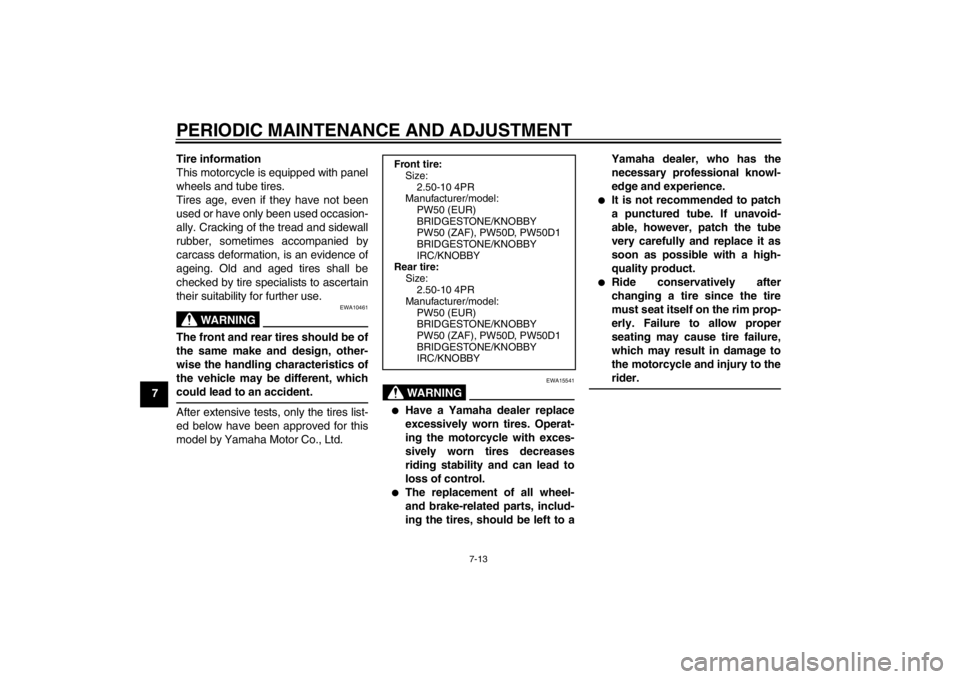
PERIODIC MAINTENANCE AND ADJUSTMENT
7-13
7Tire information
This motorcycle is equipped with panel
wheels and tube tires.
Tires age, even if they have not been
used or have only been used occasion-
ally. Cracking of the tread and sidewall
rubber, sometimes accompanied by
carcass deformation, is an evidence of
ageing. Old and aged tires shall be
checked by tire specialists to ascertain
their suitability for further use.
WARNING
EWA10461
The front and rear tires should be of
the same make and design, other-
wise the handling characteristics of
the vehicle may be different, which
could lead to an accident.After extensive tests, only the tires list-
ed below have been approved for this
model by Yamaha Motor Co., Ltd.
WARNING
EWA15541
●
Have a Yamaha dealer replace
excessively worn tires. Operat-
ing the motorcycle with exces-
sively worn tires decreases
riding stability and can lead to
loss of control.
●
The replacement of all wheel-
and brake-related parts, includ-
ing the tires, should be left to a Yamaha dealer, who has the
necessary professional knowl-
edge and experience.
●
It is not recommended to patch
a punctured tube. If unavoid-
able, however, patch the tube
very carefully and replace it as
soon as possible with a high-
quality product.
●
Ride conservatively after
changing a tire since the tire
must seat itself on the rim prop-
erly. Failure to allow proper
seating may cause tire failure,
which may result in damage to
the motorcycle and injury to the
rider.
Front tire:
Size:
2.50-10 4PR
Manufacturer/model:
PW50 (EUR)
BRIDGESTONE/KNOBBY
PW50 (ZAF), PW50D, PW50D1
BRIDGESTONE/KNOBBY
IRC/KNOBBY
Rear tire:
Size:2.50-10 4PR
Manufacturer/model:
PW50 (EUR)
BRIDGESTONE/KNOBBY
PW50 (ZAF), PW50D, PW50D1
BRIDGESTONE/KNOBBY
IRC/KNOBBY
U5PG8BE0.book Page 13 Wednesday, June 27, 2012 2:53 PM
Page 55 of 76
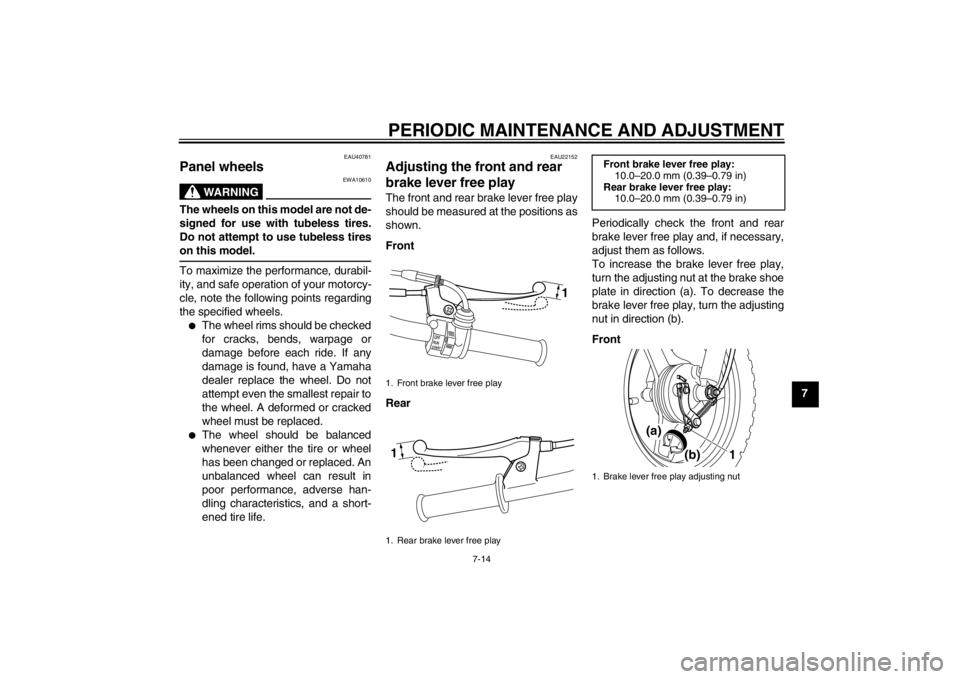
PERIODIC MAINTENANCE AND ADJUSTMENT
7-14
7
EAU40781
Panel wheels
WARNING
EWA10610
The wheels on this model are not de-
signed for use with tubeless tires.
Do not attempt to use tubeless tires
on this model.To maximize the performance, durabil-
ity, and safe operation of your motorcy-
cle, note the following points regarding
the specified wheels.●
The wheel rims should be checked
for cracks, bends, warpage or
damage before each ride. If any
damage is found, have a Yamaha
dealer replace the wheel. Do not
attempt even the smallest repair to
the wheel. A deformed or cracked
wheel must be replaced.
●
The wheel should be balanced
whenever either the tire or wheel
has been changed or replaced. An
unbalanced wheel can result in
poor performance, adverse han-
dling characteristics, and a short-
ened tire life.
EAU22152
Adjusting the front and rear
brake lever free play The front and rear brake lever free play
should be measured at the positions as
shown.
Front
RearPeriodically check the front and rear
brake lever free play and, if necessary,
adjust them as follows.
To increase the brake lever free play,
turn the adjusting nut at the brake shoe
plate in direction (a). To decrease the
brake lever free play, turn the adjusting
nut in direction (b).
Front1. Front brake lever free play
1. Rear brake lever free play
1
1
Front brake lever free play:
10.0–20.0 mm (0.39–0.79 in)
Rear brake lever free play: 10.0–20.0 mm (0.39–0.79 in)
1. Brake lever free play adjusting nut
1
(a)
(b)
U5PG8BE0.book Page 14 Wednesday, June 27, 2012 2:53 PM
Page 56 of 76
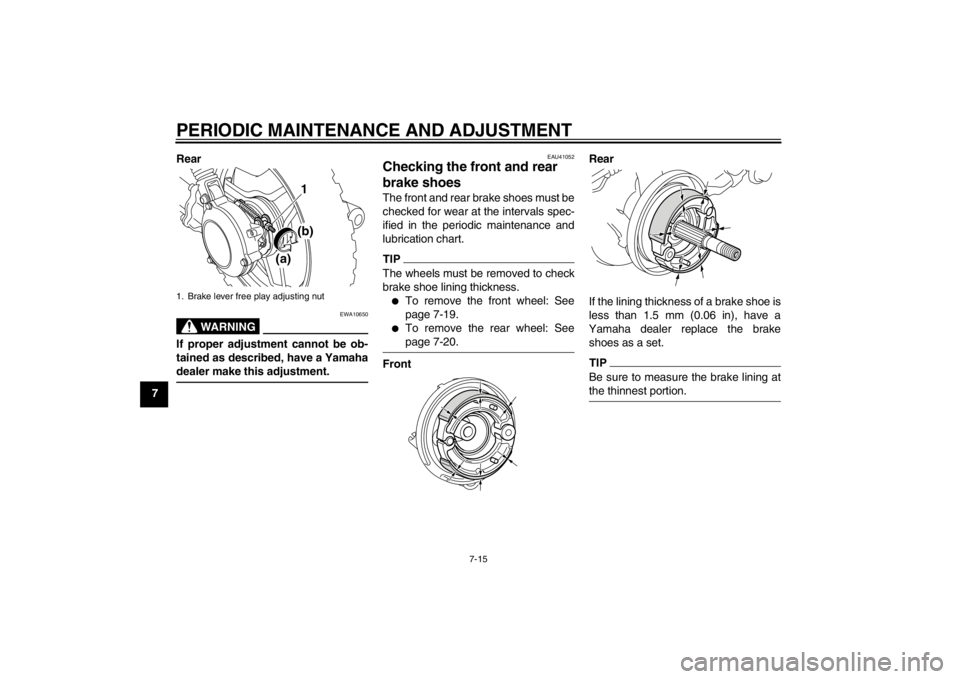
PERIODIC MAINTENANCE AND ADJUSTMENT
7-15
7Rear
WARNING
EWA10650
If proper adjustment cannot be ob-
tained as described, have a Yamaha
dealer make this adjustment.
EAU41052
Checking the front and rear
brake shoes The front and rear brake shoes must be
checked for wear at the intervals spec-
ified in the periodic maintenance and
lubrication chart.TIPThe wheels must be removed to check
brake shoe lining thickness.●
To remove the front wheel: See
page 7-19.
●
To remove the rear wheel: See
page 7-20.
Front
Rear
If the lining thickness of a brake shoe is
less than 1.5 mm (0.06 in), have a
Yamaha dealer replace the brake shoes as a set.
TIPBe sure to measure the brake lining at
the thinnest portion.
1. Brake lever free play adjusting nut
1
(a) (b)
U5PG8BE0.book Page 15 Wednesday, June 27, 2012 2:53 PM
Page 57 of 76

PERIODIC MAINTENANCE AND ADJUSTMENT
7-16
7
EAU50800
Checking and lubricating the
cables The operation of all control cables and
the condition of the cables should be
checked before each ride, and the ca-
bles and cable ends should be lubricat-
ed if necessary. If a cable is damaged
or does not move smoothly, have a
Yamaha dealer check or replace it.
WARNING! Damage to the outer housing of cables may result in in-
ternal rusting and cause interfer-
ence with cable movement. Replace
damaged cables as soon as possi-
ble to prevent unsafe conditions.[EWA10711] EAU23114
Checking and lubricating the
throttle grip and cable The operation of the throttle grip should
be checked before each ride. In addi-
tion, the cable should be lubricated by a
Yamaha dealer at the intervals speci-
fied in the periodic maintenance chart.
The throttle cable is equipped with a
rubber cover. Make sure that the cover
is securely installed. Even though the
cover is installed correctly, it does not
completely protect the cable from water
entry. Therefore, use care not to pour
water directly onto the cover or cable
when washing the vehicle. If the cable
or cover becomes dirty, wipe clean with
a moist cloth.
EAU23120
Adjusting the Autolube pump The Autolube pump is a vital and so-
phisticated component of the engine,
which must be adjusted by a Yamaha
dealer at the intervals specified in the
periodic maintenance and lubrication
chart.
Recommended lubricant:
Yamaha Chain and Cable Lube or 4-
stroke engine oil
U5PG8BE0.book Page 16 Wednesday, June 27, 2012 2:53 PM
Page 58 of 76
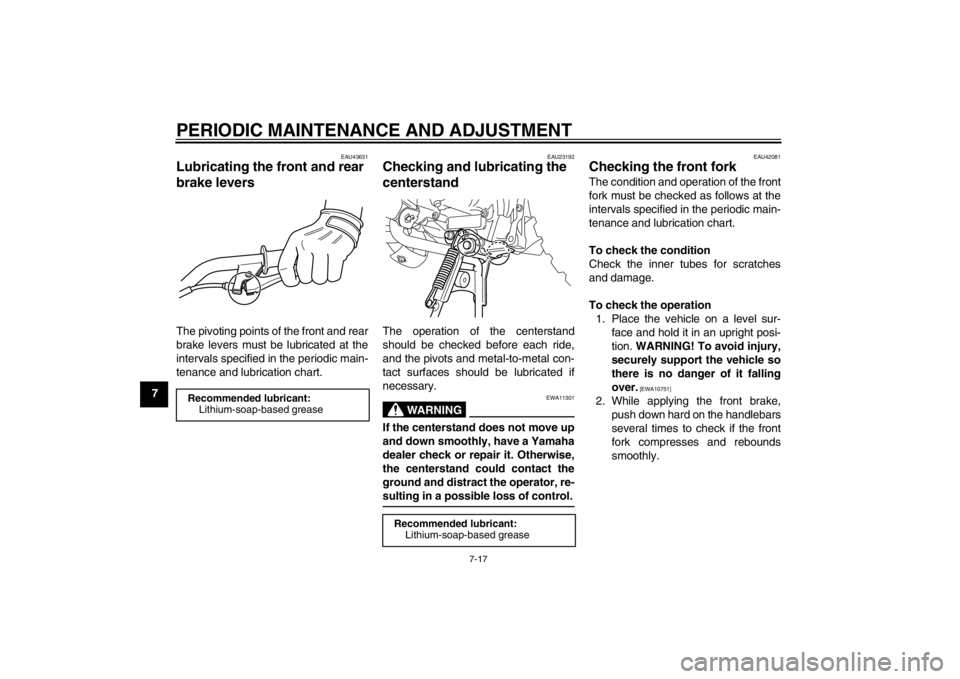
PERIODIC MAINTENANCE AND ADJUSTMENT
7-17
7
EAU43631
Lubricating the front and rear
brake levers The pivoting points of the front and rear
brake levers must be lubricated at the
intervals specified in the periodic main-
tenance and lubrication chart.
EAU23192
Checking and lubricating the
centerstand The operation of the centerstand
should be checked before each ride,
and the pivots and metal-to-metal con-
tact surfaces should be lubricated if
necessary.
WARNING
EWA11301
If the centerstand does not move up
and down smoothly, have a Yamaha
dealer check or repair it. Otherwise,
the centerstand could contact the
ground and distract the operator, re-
sulting in a possible loss of control.
EAU42081
Checking the front fork The condition and operation of the front
fork must be checked as follows at the
intervals specified in the periodic main-
tenance and lubrication chart.
To check the condition
Check the inner tubes for scratches
and damage.
To check the operation1. Place the vehicle on a level sur- face and hold it in an upright posi-
tion. WARNING! To avoid injury,
securely support the vehicle so
there is no danger of it falling
over.
[EWA10751]
2. While applying the front brake, push down hard on the handlebars
several times to check if the front
fork compresses and rebounds
smoothly.
Recommended lubricant:Lithium-soap-based grease
Recommended lubricant:Lithium-soap-based grease
U5PG8BE0.book Page 17 Wednesday, June 27, 2012 2:53 PM
Page 59 of 76
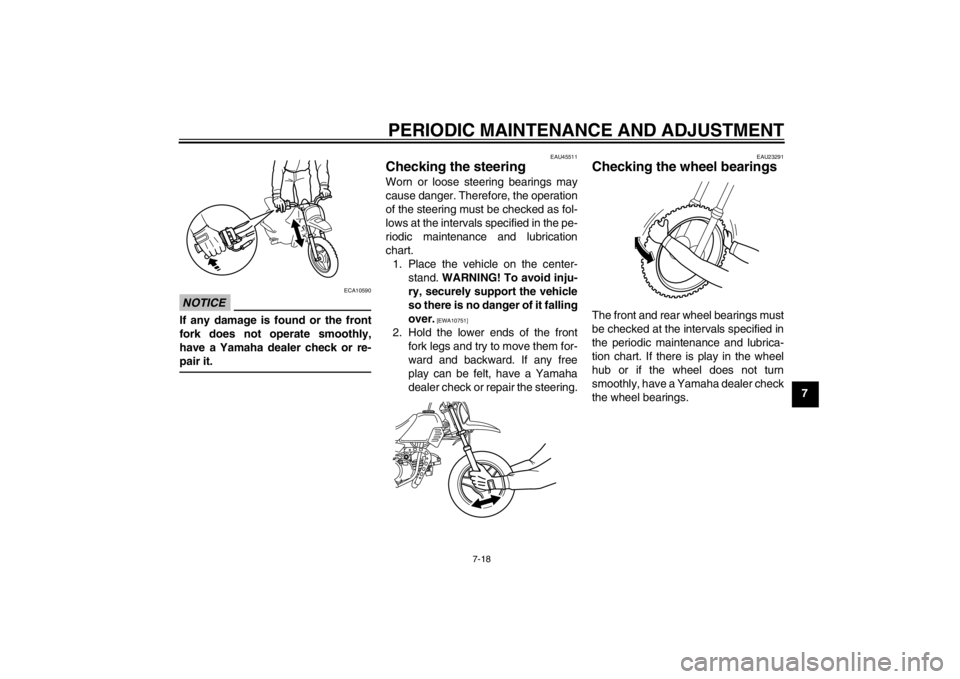
PERIODIC MAINTENANCE AND ADJUSTMENT
7-18
7
NOTICE
ECA10590
If any damage is found or the front
fork does not operate smoothly,
have a Yamaha dealer check or re-
pair it.
EAU45511
Checking the steering Worn or loose steering bearings may
cause danger. Therefore, the operation
of the steering must be checked as fol-
lows at the intervals specified in the pe-
riodic maintenance and lubrication
chart.1. Place the vehicle on the center- stand. WARNING! To avoid inju-
ry, securely support the vehicle
so there is no danger of it falling
over.
[EWA10751]
2. Hold the lower ends of the front fork legs and try to move them for-
ward and backward. If any free
play can be felt, have a Yamaha
dealer check or repair the steering.
EAU23291
Checking the wheel bearings The front and rear wheel bearings must
be checked at the intervals specified in
the periodic maintenance and lubrica-
tion chart. If there is play in the wheel
hub or if the wheel does not turn
smoothly, have a Yamaha dealer check
the wheel bearings.
U5PG8BE0.book Page 18 Wednesday, June 27, 2012 2:53 PM
Page 60 of 76
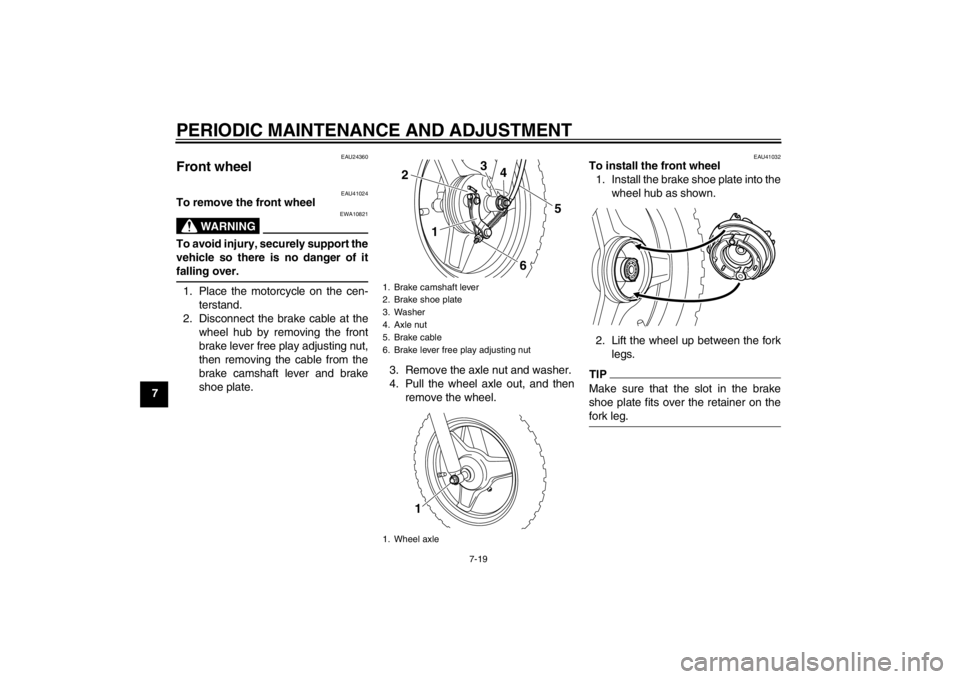
PERIODIC MAINTENANCE AND ADJUSTMENT
7-19
7
EAU24360
Front wheel
EAU41024
To remove the front wheel
WARNING
EWA10821
To avoid injury, securely support the
vehicle so there is no danger of it
falling over.1. Place the motorcycle on the cen-terstand.
2. Disconnect the brake cable at the wheel hub by removing the front
brake lever free play adjusting nut,
then removing the cable from the
brake camshaft lever and brake
shoe plate. 3. Remove the axle nut and washer.
4. Pull the wheel axle out, and then
remove the wheel.
EAU41032
To install the front wheel1. Install the brake shoe plate into the wheel hub as shown.
2. Lift the wheel up between the fork legs.TIPMake sure that the slot in the brake
shoe plate fits over the retainer on the
fork leg.
1. Brake camshaft lever
2. Brake shoe plate
3. Washer
4. Axle nut
5. Brake cable
6. Brake lever free play adjusting nut
1. Wheel axle
5
6
1 3
4
2
1
U5PG8BE0.book Page 19 Wednesday, June 27, 2012 2:53 PM